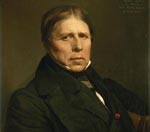Jean-Auguste Ingres

Jean-Auguste-Dominique Ingres (29 August 1780 – 14 January 1867) was a French Neoclassical painter. Although he considered himself to be a painter of history in the tradition of Nicolas Poussin and Jacques-Louis David, by the end of his life it was Ingres's portraits, both painted and drawn, that were recognized as his greatest legacy.
A man profoundly respectful of the past, he assumed the role of a guardian of academic orthodoxy against the ascendant Romantic style represented by his nemesis, Eugène Delacroix. His exemplars, he once explained, were "the great masters which flourished in that century of glorious memory when Raphael set the eternal and incontestable bounds of the sublime in art ... I am thus a conservator of good doctrine, and not an innovator." Nevertheless, modern opinion has tended to regard Ingres and the other Neoclassicists of his era as embodying the Romantic spirit of his time, while his expressive distortions of form and space make him an important precursor of modern art.
Ingres was steeped in the academic tradition, which centred on study from the nude and classical art. He became the defender of a rigid classicism which contrasted with the Romanticism of Delacroix.
Ingres saw himself as a history painter, the highest goal of academic art. Portraiture he thought of less importance, but he is now most famous for works like 'Madame Moitessier' as well for his escapist scenes of the Orient.
Ingres came to national prominence as a pupil of Jacques-Louis David and as a student at the Ecole des Beaux-Arts, Paris. He won a scholarship to Rome in 1801 which he took up in 1806, partly because of an unfavourable reception at the Paris Salon.
Under the influence of Italian art (particularly Raphael) he mastered portraiture. He also painted small pictures illustrating literary texts, scenes from French history or the lives of artists, which were sold to the French crown. He returned to France, where he became Director of the French Academy. Ingres was also an accomplished violinist who could have had a successful career as a musician: the French phrase for having a second string to one's bow is a 'violon d'Ingres'.
